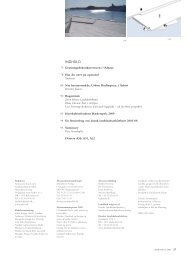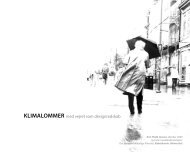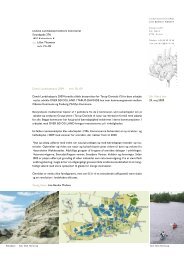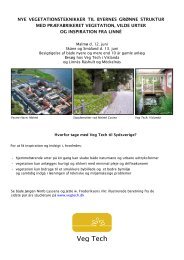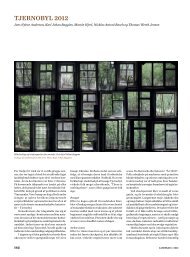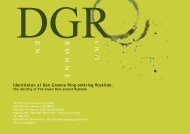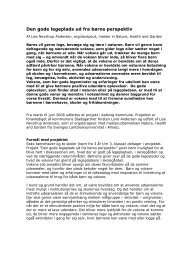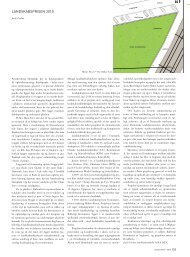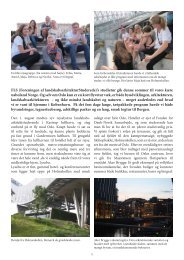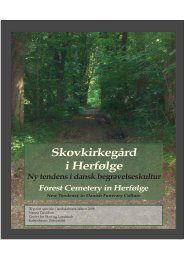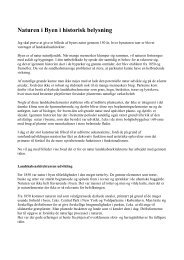landskab 3 2012 - Danske Landskabsarkitekter
landskab 3 2012 - Danske Landskabsarkitekter
landskab 3 2012 - Danske Landskabsarkitekter
You also want an ePaper? Increase the reach of your titles
YUMPU automatically turns print PDFs into web optimized ePapers that Google loves.
summary<br />
Urban Play, p. 84<br />
Bettina Lamm and Charlotte Bagger Brandt<br />
With our multidisciplinary approach we share<br />
a vision that through architectural and artistic<br />
strategies we can create new settings for play,<br />
life and engagement in public spaces. In our<br />
approach to the project Urban Play we don’t<br />
differentiate between the common professional<br />
boundaries; artist, curator, architect<br />
and city planner. In this way we participate as<br />
creative players in the project. We create and<br />
map the playing board, so to speak, its rules<br />
and its visualization with our respective experiences<br />
as landscape architect and curator/art<br />
historian and we invite a mixed bag of artists,<br />
architects and urban space activists to participate<br />
in this urban game.<br />
www.urbanplay.dk<br />
Therapy garden Nacadia: Evidence-based<br />
health design, p. 88<br />
Ulrika K. Stigsdotter, Maja Steen Møller,<br />
Sus Sola Corazon and Victoria Linn Lygum<br />
At the therapy garden Nacadia a so-called<br />
mindfulness-inspired garden therapy is employed<br />
where the garden is used as a therapeutical<br />
tool, so that the patients’ experiences,<br />
sense impressions, activities and relations to<br />
the nature environment are a significant part<br />
of the therapeutical process. But in addition<br />
to being a treatment place, Nacadia will also<br />
serve as a research, development and demonstration<br />
project in the area of ‘evidence-based<br />
health design’ and stress therapy. An important<br />
aspect in Skov & Landskab’s interpretation<br />
of evidence-based health design is that<br />
the process does not stop when the garden is<br />
completed. The therapy garden is considered<br />
as a process in itself, where new research and<br />
documented experience will continuously add<br />
new and strong evidence to the design so that<br />
Nacadia can constantly develop.<br />
Where is the volume knob on a tree? – design<br />
in a broad sense, p. 92<br />
Torben Dam, Jan Støvring and Palle Kristoffersen<br />
Design – in the word’s broad sense – is perhaps<br />
the phrase that is most descriptive when<br />
a planting proposal is created on the drawing<br />
board. But plants should grow and develop in<br />
an interplay with other plants, soil conditions<br />
and the urban space. In this course, plants and<br />
technology at the landscape architect education<br />
at Copenhagen University are instrumental<br />
in getting the students to formulate<br />
architectural goals for their planting proposals<br />
before they decide the individual plant<br />
species. The goal is a sustainable, structured<br />
planting.<br />
The landscape architecture education at<br />
Copenhagen University anno <strong>2012</strong>, p. 96<br />
Karen Sejr<br />
Landscape architecture and city planning at<br />
Copenhagen University combine creativity<br />
and aesthetics with biological knowledge. It is<br />
a practice-oriented education with a focus on<br />
plants, design, nature, urban life and a good<br />
study environment.<br />
On September 1, 2011, 75 new students<br />
started their bachelor’s education in landscape<br />
architecture at Copenhagen University.<br />
During the entire first study year, the<br />
students participate in the course Plan and<br />
Design. Here the focus is placed on landscape<br />
architecture’s means, space, scale, color, etc.<br />
and the tools that landscape architects use,<br />
plan, section, model and spatial visualizations.<br />
Through lectures and excursions, the<br />
students are made aware of the profession’s<br />
wide variety of works. They also gain knowledge<br />
of the broad extent of the landscape<br />
architectural language: avenues and axes, the<br />
gardens of the baroque and romanticist periods<br />
and elements such as point de vue and<br />
trompe-l'oeil.<br />
At the moment there is no special course<br />
in Landscape architecture history, but Richard<br />
Hare, who is head of the bachelor program,<br />
has given this a high priority and it is much<br />
desired on the list of courses that should be<br />
offered to landscape architecture students.<br />
The study of landscape architectural<br />
craftsmanship is supplemented by natural<br />
science courses that deal with soil, water,<br />
vegetation and ecology. And finally the different<br />
courses are linked together through<br />
project work, such as when the first year students<br />
design rainwater beds on a parking lot<br />
in northwest Copenhagen. Proposals that<br />
not only have an architectural basis but also<br />
a planting content.<br />
According to Richard Hare this is also<br />
one of the areas where the education will be<br />
improved: “For the first time this year we have<br />
been able to couple teaching in botany and the<br />
use of plants together with the course Plan<br />
and Design. This implies that already from the<br />
first year of study, we discuss the use of different<br />
plants and employ them in the design.<br />
I would like to further develop this and contribute<br />
to ensuring that the study of the use of<br />
plants becomes part of the bachelor program<br />
in the landscape architecture education as a<br />
new independent course in the use of plants.”<br />
In the second year of study, the education<br />
is divided in an Urban design package and a<br />
Landscape design package. The former deals<br />
with urban planning, the city’s structure and<br />
dynamics, and the latter focuses on plants and<br />
gardens. A common element in the two study<br />
packages is the profession’s scientific theory<br />
as well as a number of elective courses.<br />
During the third year of study, there is a<br />
bachelor internship after Christmas. These<br />
internships are at green administration<br />
offices in the Danish municipalities or at private<br />
offices, both large and small. And finally<br />
the landscape architect students in the bachelor<br />
program in recent years have used the<br />
opportunity to work abroad. This includes<br />
cities like Seattle and New York City in USA,<br />
and in Holland, Germany and France.<br />
The master’s program is run in English<br />
and offers three different specialized programs:<br />
Landscape Planning, Urban Design and<br />
Green Space Management.<br />
The goal of the Landscape Planning program<br />
is to strengthen the students’ competencies<br />
in design, both on a theoretical and<br />
practical level. This specialization is based on<br />
two obligatory courses: Theory and Method in<br />
Landscape Architecture and Landscape Planning.<br />
In addition to this there are a number of<br />
elective courses and finally the degree projects,<br />
which in most cases last a half year. This<br />
applies to all three specializations.<br />
Urban Design combines the development<br />
of strategies with design-interventions and<br />
provides a foundation in ecological urbanism.<br />
This program is base on the courses Theories<br />
of Urban Design, Urban Ecosystems and The<br />
Urbanism Studio.<br />
Green Space Management focuses on the<br />
socio-political and organizational aspects<br />
of the administration and planning of green<br />
areas. The basis for this program is the<br />
courses Urban Forestry & Urban Greening<br />
and the new course Design by management,<br />
which is based on the fact that the design of<br />
our green spaces is to a great degree the result<br />
of care and cultivation.<br />
A few years ago, the master’s program in<br />
landscape architecture was converted to an<br />
international, English language education.<br />
This has been a challenge, but in most cases<br />
a great advantage for the program. It attracts<br />
many talented foreign students who use the<br />
opportunity to learn about the Nordic tradition<br />
and about Danish landscape architecture,<br />
and who contribute to heightening the level<br />
among the Danish master students.<br />
The cosmopolitan environment provides<br />
the Danish students with an international net-<br />
work, the ability to communicate landscape<br />
architecture theory in English and the courage<br />
to study abroad – and give future landscape<br />
architects the ability to work abroad.<br />
www.sl.life.ku.dk<br />
Pete Avondoglio<br />
100 LANDSKAB 3 <strong>2012</strong>



